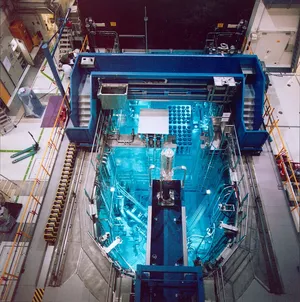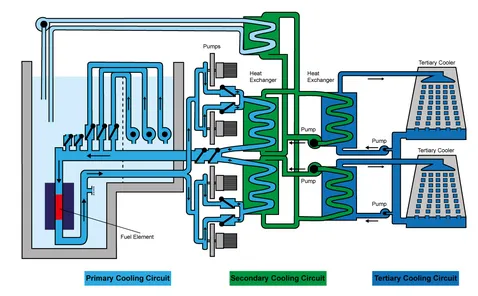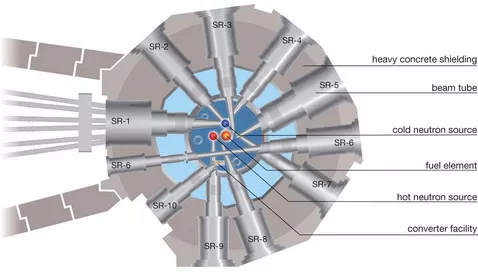Reactor

FRM II produces free neutrons by utilizing the chain reaction of the fission of uranium. In lay terms, such systems are referred to as "nuclear reactors". A nuclear reactor is said to be "critical" if the number of neutrons produced and the number of neutrons absorbed is equal. In this case, the facility is at constant power in a stable equilibrium state.
The main components of FRM II are
- the fuel element, which provides the supply of uranium (the reactivity reserve),
- the different cooling circuits, which dissipate the heat generated by the fission process,
- the regulatory and control systems, e.g environmental monitoring
- extensive safety systems for nuclear, conventional safety as well as plant reliability,
- the beam guidance systems that transport the neutrons to the experiments and
- numerous auxiliary and ancillary systems, from the provision of desalinated water to air conditioning, the disposal of waste water, crane systems and transport vehicles and many other facilities.
Cooling circuits
During nuclear fission, fission products as well as free neutrons are created. The latter initially move very fast and have to be slowed down to keep the controlled chain reaction running.
Three completely separated cooling circuits
This deceleration is achieved particularly effectively by collisions with hydrogen atoms, e.g. water molecules, in which the kinetic energy of the neutrons is converted into heating the cooling chain of three hydraulically, separated but thermally connected cooling circuits. The primary circuit runs directly through the fuel element. The four main coolant pumps deliver approximately 300 l/s of water, which heats up from approximately 35 °C to 50 °C as it passes through the fuel element. This heat is transferred to the secondary circuit via two heat exchangers.
Both the primary and secondary circuits are located entirely within the reactor building. The tertiary circuit in turn is thermally connected via a heat exchanger to the secondary circuit. Only the tertiary circuit leads outside to the cooling towers in which the heat is primarily dissipated via evaporation to the ambient air.
Besides this main cooling chain, there are several secondary cooling circuits which ensure the cooling of other units e.g. the ambient air or experimental facilities.
Guiding the beams
Neutrons are electrically neutral components of atomic nuclei, have a diameter of ca. 1.7 × 10-15 m and usually penetrate matter easily. Therefore they can only be "guided" in a very limited way. Initially, they fly in all directions with a mean velocity determined by the temperature of the moderator and one could use in experiments only those neutrons that would by chance be flying in the right direction. In this case, only very few would arrive at the experiment, because their number would decrease with the square of the distance (i.e. at 2 m distance from the fuel element, 4 times fewer neutrons would be available than at 1 m distance).
Neutron guides bundle neutrons
But neutrons are also matter waves, that is, they obey the laws of optics, as we know them from visible light. Neutron guide through bundled reflection allows the forwarding of a wide wavelength band of neutrons. The diffraction of neutrons on single crystals permits, as in a prism at certain angles, the separation of certain colours, ie the monochromization of the neutron guide light. Compared to the optics with visible light it is to be noted, however, that the refractive difference between vacuum and matter is smaller for the neutron light by many orders of magnitude, ie, all optical components for the guidance of the neutron light are very large.
Eleven beam tubes provide neutrons for experiments
These neutron guides or single crystals for monochromatisation cannot be placed directly in the moderator due to anticipated irradiation damage. Typically, the first optical guiding components start 2-5 metres beyond the fuel element, still in the beam tube channels. In total, the FRM II has 10 horizontal and one inclined beam tube, which regularly provide neutrons for numerous experiments.

